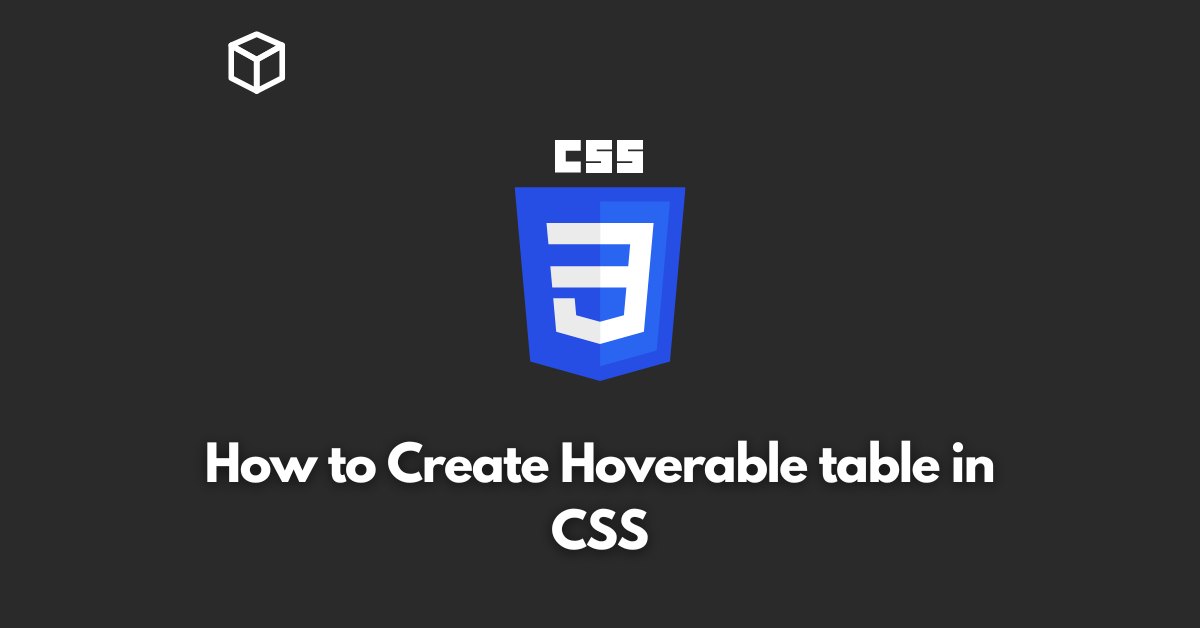Creating a hoverable table in CSS is a great way to add interactivity and visual interest to your website.
In this tutorial, we’ll go over the steps for creating a hoverable table in CSS, including code examples and tips for optimizing the table for SEO.
Step 1: Create the HTML Table
The first step in creating a hoverable table in CSS is to create the table structure using HTML. A basic table structure looks like this:
<table>
<tr>
<th>Header 1</th>
<th>Header 2</th>
<th>Header 3</th>
</tr>
<tr>
<td>Row 1, Cell 1</td>
<td>Row 1, Cell 2</td>
<td>Row 1, Cell 3</td>
</tr>
<tr>
<td>Row 2, Cell 1</td>
<td>Row 2, Cell 2</td>
<td>Row 2, Cell 3</td>
</tr>
</table>Step 2: Add CSS Styles to the Table
Once the table structure is in place, the next step is to add CSS styles to the table to make it hoverable.
Here is an example of some basic CSS styles that can be used to create a hover effect on table rows:
table {
width: 100%;
border-collapse: collapse;
}
th, td {
border: 1px solid #ccc;
padding: 8px;
text-align: left;
}
tr:hover {
background-color: #f5f5f5;
}Step 3: Optimize the Table for SEO
To ensure that your hoverable table is optimized for SEO, it’s important to use proper table markup and include relevant keywords in the table headers.
Here are a few tips for optimizing your table for SEO:
- Use the <th> tag for table headers and the <td> tag for table data.
- Use <caption> tag for providing caption to the table.
- Use ‘scope’ attribute to define the header cells that apply to the row or column.
Step 4: Make it Accessible
Ensure to make the table accessible to users who use assistive technologies like screen readers.
This can be done by adding a <caption> tag to the table to provide a brief summary of the table content, and by using the <th> tag to define table headers.
Conclusion
Creating a hoverable table in CSS is a great way to add interactivity and visual interest to your website.
By following the steps outlined in this post and optimizing the table for SEO, you can create a hoverable table that is both visually appealing and easy for search engines to understand.
Code Examples:
<table>
<caption>Employee List</caption>
<tr>
<th scope="col">Name</th>
<th scope="col">Designation</th>
<th scope="col">Salary</th>
</tr>
<tr>
<td>John Doe</td>
<td>Developer</td>
<td>$75,000</td>
</tr>
<tr>
<td>Jane Smith</td
<td>Manager</td>
<td>$100,000</td>
</tr>
</table>
table {
width: 100%;
border-collapse: collapse;
}
th, td {
border: 1px solid #ccc;
padding: 8px;
text-align: left;
}
tr:hover {
background-color: #f5f5f5;
}With these simple steps and code examples, you can easily create a hoverable table in CSS that is optimized for both user experience and search engine optimization.
Remember to make it accessible too, by providing summary and using ‘scope’ attribute.




